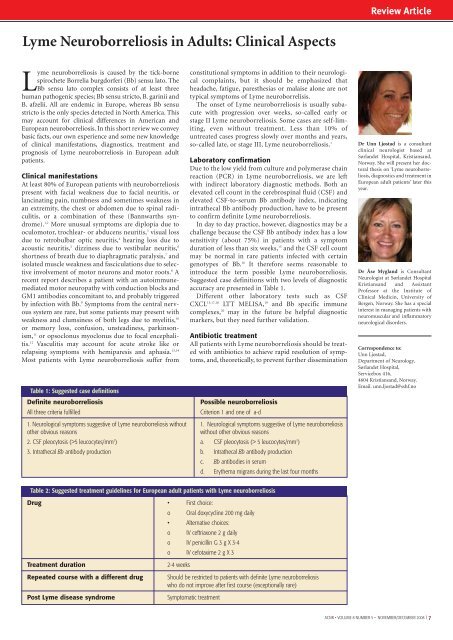Unn Ljøstad and Åse Mygland Jone Furlund Owe and Nils ... - ACNR
Unn Ljøstad and Åse Mygland Jone Furlund Owe and Nils ... - ACNR
Unn Ljøstad and Åse Mygland Jone Furlund Owe and Nils ... - ACNR
Create successful ePaper yourself
Turn your PDF publications into a flip-book with our unique Google optimized e-Paper software.
Review Article<br />
Lyme Neuroborreliosis in Adults: Clinical Aspects<br />
Lyme neuroborreliosis is caused by the tick-borne<br />
spirochete Borrelia burgdorferi (Bb) sensu lato. The<br />
Bb sensu lato complex consists of at least three<br />
human pathogenic species; Bb sensu stricto, B. garinii <strong>and</strong><br />
B. afzelii. All are endemic in Europe, whereas Bb sensu<br />
stricto is the only species detected in North America. This<br />
may account for clinical differences in American <strong>and</strong><br />
European neuroborreliosis. In this short review we convey<br />
basic facts, our own experience <strong>and</strong> some new knowledge<br />
of clinical manifestations, diagnostics, treatment <strong>and</strong><br />
prognosis of Lyme neuroborreliosis in European adult<br />
patients.<br />
Clinical manifestations<br />
At least 80% of European patients with neuroborreliosis<br />
present with facial weakness due to facial neuritis, or<br />
lancinating pain, numbness <strong>and</strong> sometimes weakness in<br />
an extremity, the chest or abdomen due to spinal radiculitis,<br />
or a combination of these (Bannwarths syndrome).<br />
1,2 More unusual symptoms are diplopia due to<br />
oculomotor, trochlear- or abducens neuritis, 3 visual loss<br />
due to retrobulbar optic neuritis, 4 hearing loss due to<br />
acoustic neuritis, 5 dizziness due to vestibular neuritis, 6<br />
shortness of breath due to diaphragmatic paralysis, 7 <strong>and</strong><br />
isolated muscle weakness <strong>and</strong> fasciculations due to selective<br />
involvement of motor neurons <strong>and</strong> motor roots. 8 A<br />
recent report describes a patient with an autoimmunemediated<br />
motor neuropathy with conduction blocks <strong>and</strong><br />
GM1 antibodies concomitant to, <strong>and</strong> probably triggered<br />
by infection with Bb. 9 Symptoms from the central nervous<br />
system are rare, but some patients may present with<br />
weakness <strong>and</strong> clumsiness of both legs due to myelitis, 10<br />
or memory loss, confusion, unsteadiness, parkinsonism,<br />
11 or opsoclonus myoclonus due to focal encephalitis.<br />
12 Vasculitis may account for acute stroke like or<br />
relapsing symptoms with hemiparesis <strong>and</strong> aphasia. 13,14<br />
Most patients with Lyme neuroborreliosis suffer from<br />
Table 1: Suggested case definitions<br />
Definite neuroborreliosis<br />
All three criteria fulfilled<br />
constitutional symptoms in addition to their neurological<br />
complaints, but it should be emphasized that<br />
headache, fatigue, paresthesias or malaise alone are not<br />
typical symptoms of Lyme neuroborrelisis.<br />
The onset of Lyme neuroborreliosis is usually subacute<br />
with progression over weeks, so-called early or<br />
stage II Lyme neuroborreliosis. Some cases are self-limiting,<br />
even without treatment. Less than 10% of<br />
untreated cases progress slowly over months <strong>and</strong> years,<br />
so-called late, or stage III, Lyme neuroborreliosis. 1<br />
Laboratory confirmation<br />
Due to the low yield from culture <strong>and</strong> polymerase chain<br />
reaction (PCR) in Lyme neuroborreliosis, we are left<br />
with indirect laboratory diagnostic methods. Both an<br />
elevated cell count in the cerebrospinal fluid (CSF) <strong>and</strong><br />
elevated CSF-to-serum Bb antibody index, indicating<br />
intrathecal Bb antibody production, have to be present<br />
to confirm definite Lyme neuroborreliosis.<br />
In day to day practice, however, diagnostics may be a<br />
challenge because the CSF Bb antibody index has a low<br />
sensitivity (about 75%) in patients with a symptom<br />
duration of less than six weeks, 15 <strong>and</strong> the CSF cell count<br />
may be normal in rare patients infected with certain<br />
genotypes of Bb. 16 It therefore seems reasonable to<br />
introduce the term possible Lyme neuroborreliosis.<br />
Suggested case definitions with two levels of diagnostic<br />
accuracy are presented in Table 1.<br />
Different other laboratory tests such as CSF<br />
CXCL 13,17,18 LTT MELISA, 19 <strong>and</strong> Bb specific immune<br />
complexes, 20 may in the future be helpful diagnostic<br />
markers, but they need further validation.<br />
Antibiotic treatment<br />
All patients with Lyme neuroborreliosis should be treated<br />
with antibiotics to achieve rapid resolution of symptoms,<br />
<strong>and</strong>, theoretically, to prevent further dissemination<br />
Possible neuroborreliosis<br />
Criterion 1 <strong>and</strong> one of a-d<br />
1. Neurological symptoms suggestive of Lyme neuroborreliosis without 1. Neurological symptoms suggestive of Lyme neuroborreliosis<br />
other obvious reasons<br />
without other obvious reasons<br />
2. CSF pleocytosis (>5 leucocytes/mm 3 ) a. CSF pleocytosis (> 5 leucocytes/mm 3 )<br />
3. Intrathecal Bb antibody production b. Intrathecal Bb antibody production<br />
c. Bb antibodies in serum<br />
d. Erythema migrans during the last four months<br />
Dr <strong>Unn</strong> Ljøstad is a consultant<br />
clinical neurologist based at<br />
Sørl<strong>and</strong>et Hospital, Kristians<strong>and</strong>,<br />
Norway. She will present her doctoral<br />
thesis on ‘Lyme neuroborreliosis,<br />
diagnostics <strong>and</strong> treatment in<br />
European adult patients’ later this<br />
year.<br />
Dr Åse Mygl<strong>and</strong> is Consultant<br />
Neurologist at Sørl<strong>and</strong>et Hospital<br />
Kristians<strong>and</strong> <strong>and</strong> Assistant<br />
Professor at the Institute of<br />
Clinical Medicin, University of<br />
Bergen, Norway. She has a special<br />
interest in managing patients with<br />
neuromuscular <strong>and</strong> inflammatory<br />
neurological disorders.<br />
Correspondence to:<br />
<strong>Unn</strong> Ljøstad,<br />
Department of Neurology,<br />
Sørl<strong>and</strong>et Hospital,<br />
Servicebox 416,<br />
4604 Kristians<strong>and</strong>, Norway.<br />
Email. unn.ljostad@sshf.no<br />
Table 2: Suggested treatment guidelines for European adult patients with Lyme neuroborreliosis<br />
Drug • First choice:<br />
o Oral doxycycline 200 mg daily<br />
• Alternative choices:<br />
o IV ceftriaxone 2 g daily<br />
o IV penicillin G 3 g X 3-4<br />
o IV cefotaxime 2 g X 3<br />
Treatment duration<br />
Repeated course with a different drug<br />
Post Lyme disease syndrome<br />
2-4 weeks<br />
Should be restricted to patients with definite Lyme neuroborreliosis<br />
who do not improve after first course (exceptionally rare)<br />
Symptomatic treatment<br />
<strong>ACNR</strong> • VOLUME 8 NUMBER 5 • NOVEMBER/DECEMBER 2008 I 7

















